James Maliszewski's Blog, page 50
July 15, 2024
Tired of "Travelling?"
From issue #56 of Dragon (December 1981) comes this advertisement for Star Rovers, a science fiction RPG from Archive Miniatures & Game Systems. Nowadays, the game is mostly notable for the fact that Dave Hargrave of Arduin fame was one of its designers. I never saw it back in the day, so I can't comment on its contents or quality. However, the ad below suggests it was interesting ...

What Next?
Based on the reader response to the "A (Very Brief) Pictorial History" posts, this has proven to be a very popular series, which pleases me. With the publication of today's post on halflings, I've come to the end of those I'd originally had in mind to examine. However, I'm open to the idea of continuing the series, if there's still interest in my doing so. To do that, though, I need suggestions. About which Dungeons & Dragons monsters would you like to see pictorial history posts?
As a reminder, here are the posts I've done so far:
BugbearsDrowElvesGnollsGoblinsHalflingsKoboldsOrcsTrollsAs you can see, there aren't even ten posts in this series, so there is plenty of scope for additional ones. My interest thus far has been in humanoid monsters and races, since they're often the ones whose appearances have varied the most over the years and that's fascinating. Of course, when their appearances don't vary, that's equally interesting and also worthy of examination.Before making any suggestions of possible additions, keep one thing in mind: the monster in question has to be commonplace enough to have appeared in multiple illustrations over the course of the TSR era of D&D. That means you won't be seeing "A (Very) Pictorial History of the Water Weird" or "A (Very) Brief Pictorial History of the Brain Mole" anytime soon – unless there really is some vast store of illustrations I've somehow overlooked. Stick to well used and iconic monsters and there's a better chance I can be swayed to write about them.
 No – don't even ask.
No – don't even ask.
Mesmerized by Sirens
Though I've now been blogging for almost as long (if not as prolifically) as I had prior to my break, I still can't help but think of the period between 2008 and 2012 or thereabouts as something of a Golden Age for the Old School Renaissance. While the seeds of what would become the OSR were planted on forums like Dragonsfoot and ODD74, its true flowering occurred on blogs. By the time I started Grognardia in March 2008, there were already many blogs devoted to old school RPGs, particularly Dungeons & Dragons. Over the course of the next couple years, their numbers were swelled by many, many more, leading to a remarkable intellectual ecosystem where the history of our hobby was remembered, celebrated, and debated with incredible vibrancy. It truly was an incredible time and I often find myself nostalgic for those days.
An important aspect of those days was how often bloggers would refer their readers to posts on other blogs, whether to comment upon or even criticize them. Despite the claims by some that the OSR was an "echo chamber," anyone who was deeply immersed in the scene at the time can easily refute that. Far from being a hivemind, the early Old School Renaissance was a fractious, cantankerous place, filled with big ideas and big personalities, not all of whom saw eye to eye on every issue. Back then, it seemed as if there were a new "controversy" every week and, while that could be vexing, these squabbles regularly provided an opportunity to hash out questions of wider interest.
I used to read lots of other blogs, because I felt it was important that I keep abreast of what others were writing. Sometimes, that was a lot of work and I won't deny that the first iteration of this blog eventually wore me out to the point of disaster. Consequently, when I returned to blogging in 2020, I vowed I wouldn't exhaust myself in the way I had previously. I'd write less often and only when I felt I had something of interest to say. Grognardia was an avocation, not an occupation and I should treat it as such. For the most part, that's worked out well enough, but there's still a part of me who misses the roiling, chaotic ferment of the old days. They burned me out, yes, but they also produced a lot of great stuff.
That's why I was cheered to discover that a blog I've long enjoyed, Mesmerized by Sirens, has a new post for the first time in three years. Subtitled "the Sanctuary of Old Fantasy Role Playing Games," Mesmerized by Sirens is a great resource for information about not merely old RPGs but obscure ones – games like Bifrost, Melanda, Phantasy Conclave, Castle Perilous, and more. If you're at all interested in the dark corners of the hobby's history, I recommend you take a look. I hope that, if enough people do so, it might encourage its author to keep writing.
Do you have any defunct blogs you'd like to see return to life?
Juego de Rol de Ciencia Ficción Imperial
As many of you know, I wrote a science fiction roleplaying game called Thousand Suns. While not strictly speaking an old school RPG, it is my love letter to the "imperial science fiction" literature of the period between the 1940s and '80s – authors like Poul Anderson, Bertram Chandler, Frank Herbert, Larry Niven, H. Beam Piper, and Jerry Pournelle, among others.
Outremer Ediciones recently published a translation of the game into Spanish. I received a copy of the translated version last week and was so pleased by how nicely it turned out that I had to share a few photos.
 Here's a chapter spread:
Here's a chapter spread:
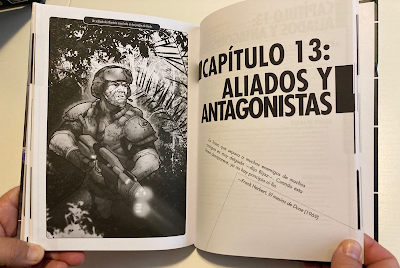 Outremer also sent me a pair of special D12 dice for use with the game. That's something I wanted to have made for the original English version, too, so I was tickled to receive these.
Outremer also sent me a pair of special D12 dice for use with the game. That's something I wanted to have made for the original English version, too, so I was tickled to receive these.
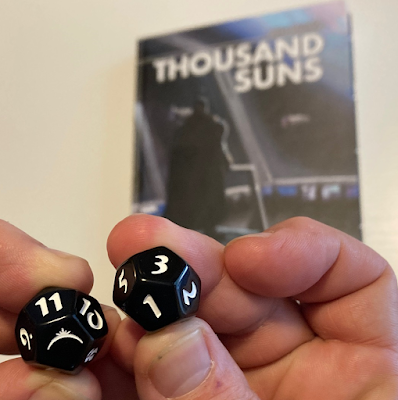 This is (I think) the first time that something I've written for publication has been translated into a foreign language. It's been a fun experience and I'm grateful to Outremer Ediciones for having done such a terrific job with Thousand Suns.
This is (I think) the first time that something I've written for publication has been translated into a foreign language. It's been a fun experience and I'm grateful to Outremer Ediciones for having done such a terrific job with Thousand Suns.
July 14, 2024
A (Very) Brief Pictorial History of Halflings
For today's look at the art of TSR era Dungeons & Dragons, I've decided to step away from monsters and instead focus on something a little different: halflings. Halflings, as everyone knows, originate in the works of J.R.R. Tolkien and have little or no antecedents in real world myth or legend. Despite Gary Gygax's well-known dislike of The Lord of the Rings, he was, however, a fan of The Hobbit, which introduced halflings – or, rather, hobbits – to the world. Both books were very popular among fantasy aficionados during the early 1970s, when D&D was born, so it's not at all surprising that Tolkien's diminutive creations should find their way into the game (along with several of his monsters). Of course, this usage was completely unauthorized and legally dubious. Saul Zaentz's Middle-earth Enterprises threatened legal actions against TSR for its usage of "hobbit" (and "ent" and "Nazgûl," I believe) in OD&D. Subsequent printings of the game, such as the one I own, changed "hobbit" to "halfling" and that term then became the common one in Dungeons & Dragons.
There are no clearly identified illustrations of halflings in OD&D. However, there is this piece of Greg Bell artwork that I think is supposed to be a halfling:
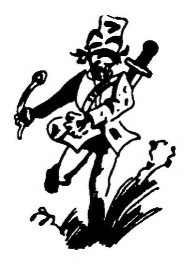 As you can see, the illustration is crude and looks more like the common depiction of a leprechaun – note the hat – than what we now expect of a hobbit or halfling. However, there are no leprechauns in OD&D, playable or otherwise. Further, if you look carefully, you can see the figure above is using a sling in his right hand, a signature weapon of halflings in both OD&D and the Fantasy Supplement to Chainmail.
As you can see, the illustration is crude and looks more like the common depiction of a leprechaun – note the hat – than what we now expect of a hobbit or halfling. However, there are no leprechauns in OD&D, playable or otherwise. Further, if you look carefully, you can see the figure above is using a sling in his right hand, a signature weapon of halflings in both OD&D and the Fantasy Supplement to Chainmail.
The earliest unambiguous illustration of a halfling comes in the AD&D Monster Manual by David Sutherland. Sutherland's depiction is broadly consonant with Tolkien's descriptions of hobbits, including their hairy feet.
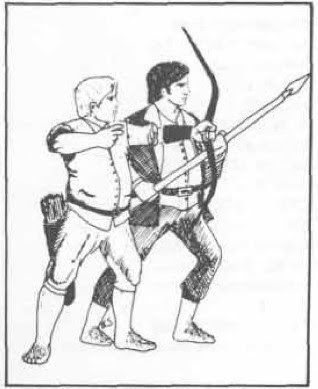 The next year, in 1978, Sutherland illustrated module B1, In Search of the Unknown. One such illustration shows a short figure I assume is meant to be a halfling. Because he has no beard, I don't think he's supposed to be a dwarf, but there's no way of knowing for certain.
The next year, in 1978, Sutherland illustrated module B1, In Search of the Unknown. One such illustration shows a short figure I assume is meant to be a halfling. Because he has no beard, I don't think he's supposed to be a dwarf, but there's no way of knowing for certain.
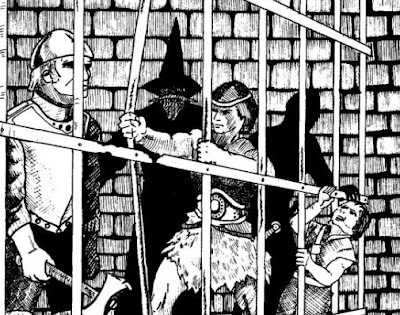 Next up is Bill Willingham's take on a halfling from the 1980 reprint of White Plume Mountain – even though it actually depicts a polymorphed efreeti masquerading as a halfling. Once again, furry feet à la Tolkien are visible.
Next up is Bill Willingham's take on a halfling from the 1980 reprint of White Plume Mountain – even though it actually depicts a polymorphed efreeti masquerading as a halfling. Once again, furry feet à la Tolkien are visible.
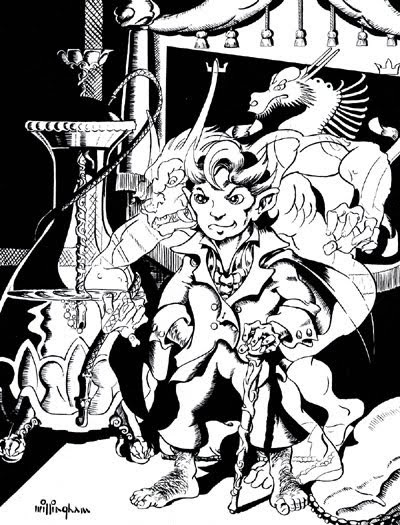 1980 also saw the release of
Slave Pits of the Undercity
, whose cover features this towheaded halfling by Jeff Dee.
1980 also saw the release of
Slave Pits of the Undercity
, whose cover features this towheaded halfling by Jeff Dee.
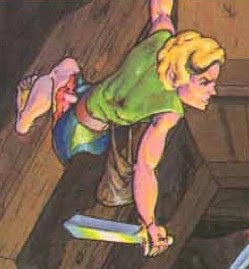 The Tom Moldvay D&D Basic Set (1981) includes this depiction of several different character classes by Dave LaForce. In the bottom right-hand corner, you can see a halfling, armed with a bow.
The Tom Moldvay D&D Basic Set (1981) includes this depiction of several different character classes by Dave LaForce. In the bottom right-hand corner, you can see a halfling, armed with a bow.
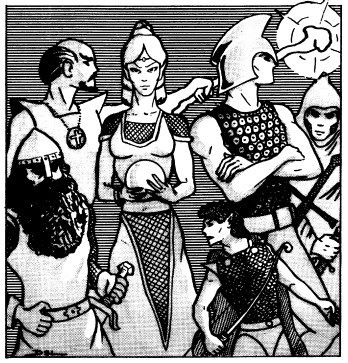 The Cook-Marsh Expert Set (1981) includes one of my favorite depictions of a D&D halfling (by Jeff Dee).
The Cook-Marsh Expert Set (1981) includes one of my favorite depictions of a D&D halfling (by Jeff Dee).
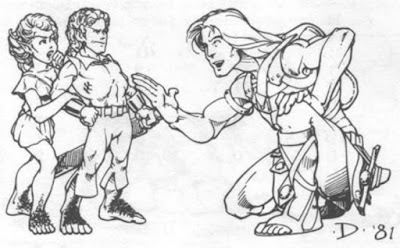 Frank Mentzer's 1983 revisions of the Basic and Expert Sets include many illustrations of halflings, probably the most of any TSR edition of Dungeons & Dragons. For the purposes of space, I'm including only a single example (by Larry Elmore), though there are many other excellent options to choose from.
Frank Mentzer's 1983 revisions of the Basic and Expert Sets include many illustrations of halflings, probably the most of any TSR edition of Dungeons & Dragons. For the purposes of space, I'm including only a single example (by Larry Elmore), though there are many other excellent options to choose from.
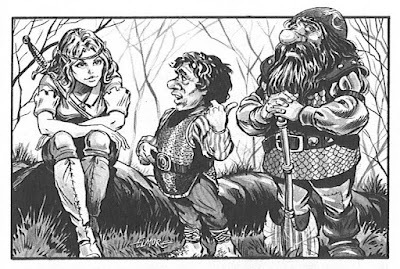 The same year saw the release of The Shady Dragon Inn, a supplement filled with artistic renderings of every conceivable D&D character type, including halflings. It also features portraits of characters based on the LJN D&D toy line, such as Figgen the Halfling Thief (whose toy, ironically, was never actually produced as far as I know). This is Timothy Truman's version of Figgen:
The same year saw the release of The Shady Dragon Inn, a supplement filled with artistic renderings of every conceivable D&D character type, including halflings. It also features portraits of characters based on the LJN D&D toy line, such as Figgen the Halfling Thief (whose toy, ironically, was never actually produced as far as I know). This is Timothy Truman's version of Figgen:
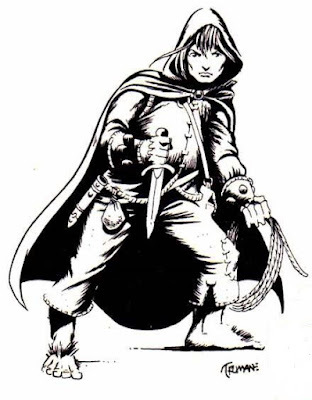 In the third episode of the first season of the Dungeons & Dragons cartoon series (also 1983), we're introduced to a character called Hector the Halfling (who's actually bad guy Venger disguised by magic). He's the only halfling to appear in the series of looks quite different than all previous depictions of the race. He lacks hairy feet, but he wears peculiar pants that cover half of his oversized feet, leaving the toes visible. He also has pointed ears, an inconsistently portrayed aspect of D&D halflings.
In the third episode of the first season of the Dungeons & Dragons cartoon series (also 1983), we're introduced to a character called Hector the Halfling (who's actually bad guy Venger disguised by magic). He's the only halfling to appear in the series of looks quite different than all previous depictions of the race. He lacks hairy feet, but he wears peculiar pants that cover half of his oversized feet, leaving the toes visible. He also has pointed ears, an inconsistently portrayed aspect of D&D halflings.
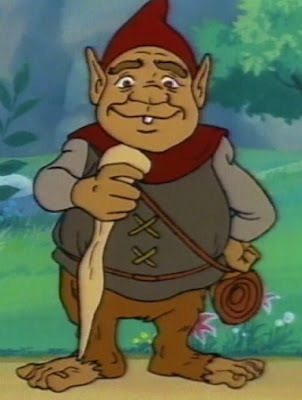 The Forgotten Realms Campaign Set (1987) presents us with another slightly anomalous vision of halflings. Jeff Easley's halflings are skinny, goofy-looking little people with mildly larcenous demeanors. They still have big, slightly hairy feet, but otherwise strike me as quite unique.
The Forgotten Realms Campaign Set (1987) presents us with another slightly anomalous vision of halflings. Jeff Easley's halflings are skinny, goofy-looking little people with mildly larcenous demeanors. They still have big, slightly hairy feet, but otherwise strike me as quite unique.
 Jim Holloway's version of halflings from 1989's Monstrous Compendium is, in my opinion, a little creepy, with his heavy eyebrows, half-lidded eyes, and languorous pose. He also boasts a veritable mane of hair that starts at his ankles and then drapes over the tops of his feet. To my eyes, the overall effect is suggestive of a satyr rather than a hobbit and I can't say I'm keen on it.
Jim Holloway's version of halflings from 1989's Monstrous Compendium is, in my opinion, a little creepy, with his heavy eyebrows, half-lidded eyes, and languorous pose. He also boasts a veritable mane of hair that starts at his ankles and then drapes over the tops of his feet. To my eyes, the overall effect is suggestive of a satyr rather than a hobbit and I can't say I'm keen on it.
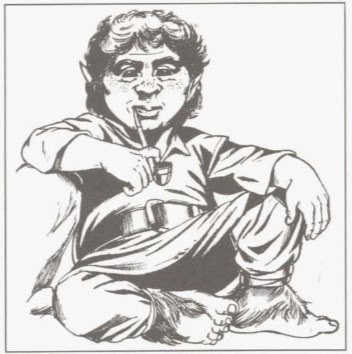 Tony DiTerlizzi's piece from the 1993 Monstrous Manual is better, exuding a kind of scrappy heroism that works well for halflings.
Tony DiTerlizzi's piece from the 1993 Monstrous Manual is better, exuding a kind of scrappy heroism that works well for halflings.
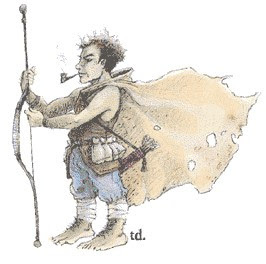 As you can see from just this small sampling of illustrations, there's never been a fully consistent conception of halflings. I wouldn't be surprised if this was driven, at least in part, by a desire to legally distinguish D&D's diminutive race from Tolkien's hobbits. At the same time, there can be no question that, at base, halflings are hobbits in all but name. The presence of hairy feet – a characteristic derived from Tolkien – in nearly all of the above pieces of artwork demonstrates that. If the intention were to avoid comparisons to the denizens of Middle-earth, you'd think removing that feature would have been at the top of the art director's list. (Interestingly, the kender of Dragonlance pointedly wear shoes – take that, Saul Zaentz!).
As you can see from just this small sampling of illustrations, there's never been a fully consistent conception of halflings. I wouldn't be surprised if this was driven, at least in part, by a desire to legally distinguish D&D's diminutive race from Tolkien's hobbits. At the same time, there can be no question that, at base, halflings are hobbits in all but name. The presence of hairy feet – a characteristic derived from Tolkien – in nearly all of the above pieces of artwork demonstrates that. If the intention were to avoid comparisons to the denizens of Middle-earth, you'd think removing that feature would have been at the top of the art director's list. (Interestingly, the kender of Dragonlance pointedly wear shoes – take that, Saul Zaentz!).There's a lot more to be said on this topic, I think, but I'll leave that to another day. For now, I'm interested in your thoughts about both the art and the place of halflings in your own D&D campaigns. Do you use them? Do you, like me, replace them with another race? Or you omit them entirely?
July 12, 2024
Barbarian Prince – Ultimate Edition
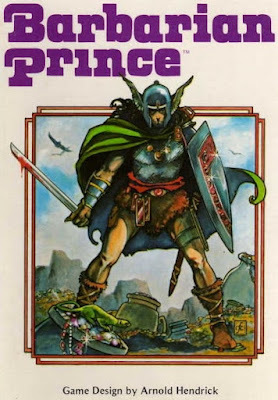 Many readers of this blog will no doubt already be familiar with the classic "solitaire game of heroic adventure in a forgotten age of barbarism and sorcery," Barbarian Prince. Originally published in 1981 by Dwarfstar Games, a division of Heritage Models, it was designed by none other than Arnold Hendrick, whose early review of OD&D is the stuff of legends. At its initial release, Barbarian Prince was very well received and continues to be highly regarded to this day. Those unfamiliar with the game – or no longer possessing a copy – are directed here for complete (and completely legal) electronic files of its components, along with those of other Dwarfstar games.
Many readers of this blog will no doubt already be familiar with the classic "solitaire game of heroic adventure in a forgotten age of barbarism and sorcery," Barbarian Prince. Originally published in 1981 by Dwarfstar Games, a division of Heritage Models, it was designed by none other than Arnold Hendrick, whose early review of OD&D is the stuff of legends. At its initial release, Barbarian Prince was very well received and continues to be highly regarded to this day. Those unfamiliar with the game – or no longer possessing a copy – are directed here for complete (and completely legal) electronic files of its components, along with those of other Dwarfstar games.According to this thread – thanks to Jacob Houck for pointing it out to me – Simon Cogan, a fan of the original game since his teenage years, is in the process of putting together an "ultimate edition" with expanded events and optional rules, as well as fixing a few errors and omissions from the original. Back in 2021, Cogan was responsible for producing a 40th anniversary edition of Barbarian Prince, so this is not new territory for him. This "director's cut" of the game will be released on August 26 in a fashion similar to his previous 40th anniversary version.
Though not official or endorsed by Dwarfstar Games, I'm nevertheless quite curious about what Cogan has in store. He's been posting weekly updates of his work on the thread linked above. Check it out if you're interested.
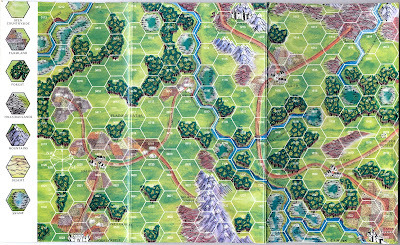
July 7, 2024
A (Very) Partial Pictorial History of Trolls
It's well known that, in populating the bestiary of Dungeons & Dragons, Arneson and Gygax regularly looked beyond mythology and folklore for inspiration. Such is obviously the case with the troll, which borrows heavily from the monster's description in Poul Anderson's Three Hearts and Three Lions right down to its green color and ability to regenerate. Unlike many of the other monsters we've looked at in this series, the troll's appearance is remarkably consistent during the TSR era of D&D. Despite the large number of artists who've drawn this horrid creature, nearly all of them seem to be using its initial appearance in 1977's Monster Manual as a guide.
In point of fact, the troll appears twice in the MM, both times drawn by Dave Sutherland. The first is on the cover:
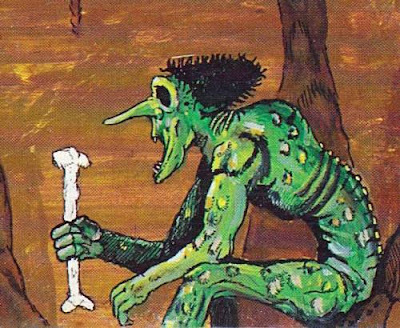 Perhaps because it's likely the first time I ever saw a D&D troll, I've always been quite fond of this particular illustration of it. The interior of the book gives us this second depiction:
Perhaps because it's likely the first time I ever saw a D&D troll, I've always been quite fond of this particular illustration of it. The interior of the book gives us this second depiction:
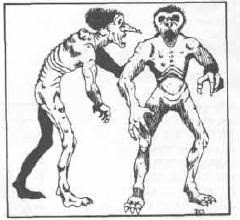 This second piece is unusual in that it depicts the same monster from two angles, like a model sheet. I can't think of any other monsters drawn this way in the Monster Manual.
This second piece is unusual in that it depicts the same monster from two angles, like a model sheet. I can't think of any other monsters drawn this way in the Monster Manual.
During the same year, Minifigs produced a figure of a troll that looks almost identical to that of Sutherland's illustration (unless the inspiration goes in the other direction). In any case, the troll's primary physical characteristics seem to be its tall, lanky body; tooth-filled mouth, long nose, black, deep-set eyes, and bristly black hair atop its elongated head.
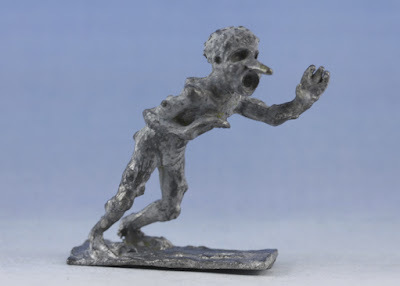 The next year, 1978, sees quite a large number of troll illustrations, starting with this one by Dave Trampier, which appeared in module G3, Hall of the Fire Giant King:
The next year, 1978, sees quite a large number of troll illustrations, starting with this one by Dave Trampier, which appeared in module G3, Hall of the Fire Giant King:
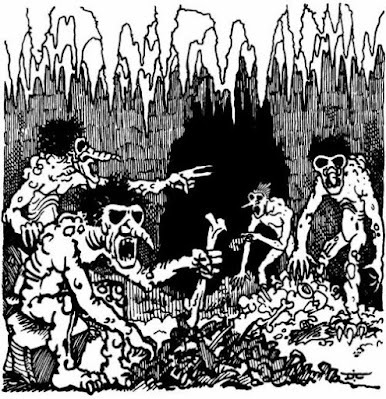 Though Tramp's style is quite different from Sutherland's, his trolls nevertheless look identical. Speaking of Sutherland, here's another one by him, this time from module D1,
Descent into the Depths of the Earth
, about which I've posted before, because it's a favorite of mine.
Though Tramp's style is quite different from Sutherland's, his trolls nevertheless look identical. Speaking of Sutherland, here's another one by him, this time from module D1,
Descent into the Depths of the Earth
, about which I've posted before, because it's a favorite of mine.
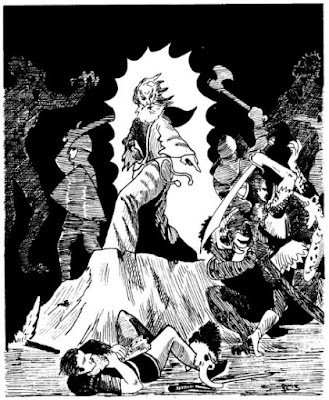 What a terrific piece! Not only is it a great battle scene, featuring men in historical armor fighting a band of trolls, it also includes possibly the only depiction of the severed body parts of a troll fighting independently. It's such a signature element of the monster that I'm surprised there are no other such depictions (you'll tell me if I'm wrong in the comments).
What a terrific piece! Not only is it a great battle scene, featuring men in historical armor fighting a band of trolls, it also includes possibly the only depiction of the severed body parts of a troll fighting independently. It's such a signature element of the monster that I'm surprised there are no other such depictions (you'll tell me if I'm wrong in the comments).Tramp returns for this fun illustration from the Players Handbook:
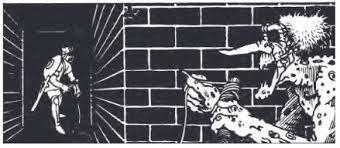 1980 brings us more trolls, starting with a Grenadier Models miniature that looks very much like the Sutherland original:
1980 brings us more trolls, starting with a Grenadier Models miniature that looks very much like the Sutherland original:
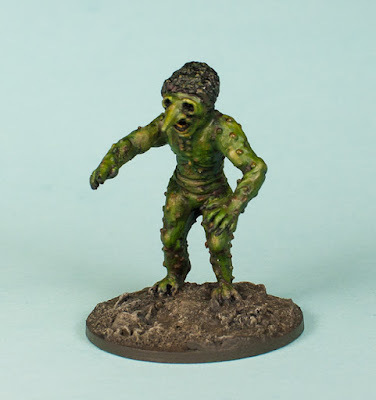 Then there's this one by Jeff Dee, appearing in the Arthurian Heroes section of
Deities & Demigods
:
Then there's this one by Jeff Dee, appearing in the Arthurian Heroes section of
Deities & Demigods
:
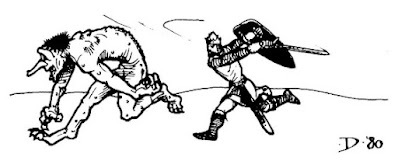 1981's Fiend Folio introduces us to several new troll variants. Though they are different sub-species, you can still see a "family resemblance," starting with this giant troll by Russ Nicholson:
1981's Fiend Folio introduces us to several new troll variants. Though they are different sub-species, you can still see a "family resemblance," starting with this giant troll by Russ Nicholson:
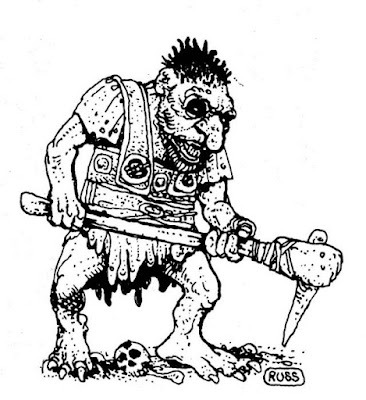 Then there's the giant, two-headed troll, another illustration by Dee:
Then there's the giant, two-headed troll, another illustration by Dee:
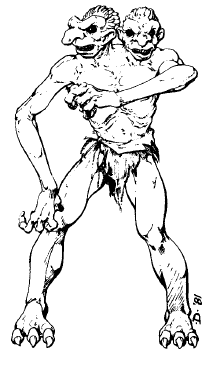 At the dawn of the Second Edition era, Jim Holloway provides this image of a troll for the
Monstrous Compendium
. Despite its small alterations to the template late down in 1977, this is still very recognizable as the same creature Sutherland originally drew.
At the dawn of the Second Edition era, Jim Holloway provides this image of a troll for the
Monstrous Compendium
. Despite its small alterations to the template late down in 1977, this is still very recognizable as the same creature Sutherland originally drew.
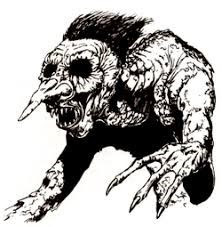
Finally, there's Tony DiTerlizzi's take from the Monstrous Manual , which is – again – just a variation on Sutherland's. There's a reason why I continue to argue that Dave Sutherland is perhaps the single most important and influential artist in the game's history.
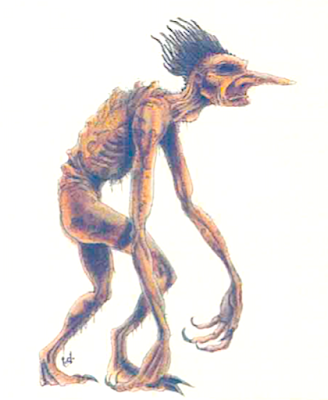 So, what have I missed? Are there any notably different takes on trolls during the TSR era? Or do they all follow in Sutherland's footsteps as these do?
So, what have I missed? Are there any notably different takes on trolls during the TSR era? Or do they all follow in Sutherland's footsteps as these do?
July 4, 2024
Polyhedron: Final Thoughts
 In my post about issue #30 of Polyhedron, I promised I'd do write a summation of my thoughts about the RPGA newszine before taking up my next series about a gaming periodical (more on that below). A combination of distraction and forgetfulness led to my not following through on that promise until today. As it turns out, this delay was probably for the best, as it's given me more time to reflect on my feelings about Polyhedron – why it worked, why it didn't, and its place within the history of the early hobby.
In my post about issue #30 of Polyhedron, I promised I'd do write a summation of my thoughts about the RPGA newszine before taking up my next series about a gaming periodical (more on that below). A combination of distraction and forgetfulness led to my not following through on that promise until today. As it turns out, this delay was probably for the best, as it's given me more time to reflect on my feelings about Polyhedron – why it worked, why it didn't, and its place within the history of the early hobby.As I've explained before, I joined the RPGA around the time issue #8 was published (October 1982), which would have been just shy of my thirteenth birthday. I did so almost entirely to gain access to Polyhedron, which I (mistakenly) saw simply as another gaming magazine akin to Dragon, to which I was already subscribed. At that particular point in my life, I lived and breathed everything TSR, so it seemed only natural that I'd want to subscribe to their other RPG periodical. I had zero interest in the RPGA itself. I was not a regular attendee of gaming conventions – I wouldn't actually attend one until 1991 – and had no interest in tournaments. My only reason for joining was to get Polyhedron delivered to my mailbox.
Consequently, I was frequently disappointed in Polyhedron. Not only was it much shorter than Dragon in terms of page count, but its content was also often too focused (in my opinion anyway) on matters of little interest to me, like the results of Dungeons & Dragons tournaments, changes to the scoring system for these tournaments, and similar ephemera. If you look back over my recent reviews of the 'zine's issues, some of that disinterest is still very much in evidence there. I never understood why it was that so many pages were given over to covering cons and subjects related to them. To me, that seemed like a waste of space that could have been better served by the inclusion of new articles about TSR roleplaying games.
While I portray this as my problem, I get the impression that quite a number of people who subscribed to Polyhedron felt similarly. That's why, as time went by, its page count expanded and its content started to include of the material that I'd always been looking for. I was especially pleased when I'd see articles penned by TSR employees, like James M. Ward or Frank Mentzer, because they carried with them an air of authority that, in my younger days, was important. It seems silly in retrospect, but, as a good disciple of "TSR Gary," I'd accept no substitutes when it came to my gaming material. If it didn't come from TSR or someone associated with the company, I'd have no part of it. Polyhedron thus filled an important role of (eventually) providing me with more TSR-approved content for its RPGs.
Even so, the content in Polyhedron was wildly inconsistent, even when penned by luminaries of the hobby. While I, for example, appreciated all the new Gamma World articles that appeared in Polyhedron over the course of the years I subscribed to it, a lot of those articles felt like filler rather than carefully considered content. This was true of the articles published to support other games, too. That's not to say there weren't numerous excellent pieces – far from it – but, compared to Dragon or White Dwarf, they were fewer. The quality of the articles became even more wildly inconsistent as more of its articles were written by RPGA members rather than TSR staffers. This is understandable, since, as I've noted before, Polyhedron did not pay for its articles. Any writer of real talent would thus focus his attentions on getting published in Dragon instead.
Based on my re-reading of the first thirty issues of Polyhedron, I don't think TSR ever really had a clear sense of what to do with Polyhedron. Initially, the goal was probably to produce a short periodical to keep members of the RPGA abreast of its activities, with some "exclusive" content to make members feel special. Once people like me started joining the RPGA solely for access to that exclusive content, its editors responded – haphazardly, it's true – with constant expansions and innovations intended to appeal to this new group of members. The result was a periodical that varied a lot from issue to issue, both in terms of content and quality. Polyhedron was constantly reinventing itself and it showed.
That said, I still have an affection for Polyhedron. I wouldn't have devoted so many posts to covering it if I hadn't. Nevertheless, I also view it as more of a mixed success than Dragon or White Dwarf, both of which eventually settled into a solid consistency. That's why I subscribed to both of them longer than I did to Polyhedron and why, even now, I'm much more likely to reference articles or ideas that first appeared in their pages rather than those in Polyhedron.
Which brings me to the next series I'll be undertaking: The Articles of Dragon. Longtime readers might well ask, "Haven't you already done an Articles of Dragon series?" Yes, I have, but I will be taking a slightly different tack with this "relaunch." In the past, I focused only on a single article from each issue and then summarized it. Now, I wish to write about each and every article that made an impression on me in my younger days and why. This might mean I will linger over one issue for several posts, while other issues will be skipped entirely. The only consideration is whether or not an article had an impact on me or my gaming. This series is, therefore, as much about my own development as a roleplayer and referee as it is about the articles themselves. We'll see if this slightly different approach proves to be appealing or not ...
July 2, 2024
Retrospective: Secret of the Slavers Stockade
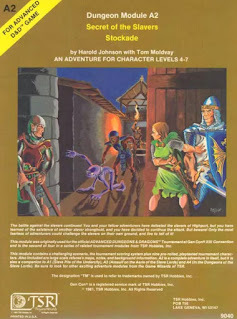 The "Slave Lords" series of AD&D modules consists of four modules, beginning with
Slave Lords of the Undercity
, about which I have fond, if complicated, feelings. Truth be told, that's true of all the modules in the A-series, They're a mix of compelling ideas, some memorable encounters, and contrived situations in order to serve their purpose as tournament scenarios. When TSR published them, the designers cleaned them up for more general use, to varying degrees of effectiveness.
The "Slave Lords" series of AD&D modules consists of four modules, beginning with
Slave Lords of the Undercity
, about which I have fond, if complicated, feelings. Truth be told, that's true of all the modules in the A-series, They're a mix of compelling ideas, some memorable encounters, and contrived situations in order to serve their purpose as tournament scenarios. When TSR published them, the designers cleaned them up for more general use, to varying degrees of effectiveness. The second module in the series, Secret of the Slavers Stockade, by Harold Johnson with assistance from Tom Moldvay, is, in my opinion, one of the better ones. Its premise is that the characters have a map to an old fort in the hills that is really a front for the salvers. Their goal is to investigate the fort and, if possible, disrupt the operations of the slavers within. It's a solid basis for an adventure, one that demands stealth and thoughtful action to succeed.
The fort (the titular Slavers' Stockade, which gets an apostrophe in the text but not on the cover) is large and well defended, with plenty of guards whose presence makes it difficult for the characters to move about. In fact, the place is so well defended that the tournament scoring system operates under the assumption that, after three hours of play, the characters will not make it very far into the fort. In addition, there's a section specifically devoted to "hill fort strategy," detailing how the guards will respond once it becomes apparent there are intruders in their midst. That's not even factoring in wandering monsters. In short, the characters have their job cut out for them.
Ultimately, to put an end to the threat of the Stockade, the characters will need to find and kill its overseer, Markessa, an evil female elf fighter/magic-user, who keeps a pet owlbear and is guarded by goblins. Here's Jim Roslof's illustration of her and two goblins.
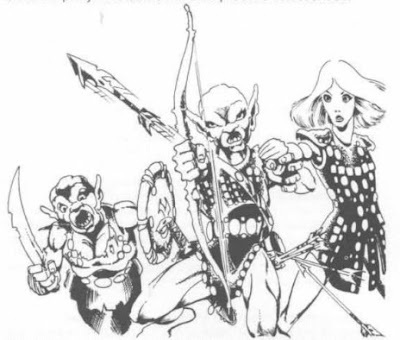 These goblins look a lot like Roslof's depiction of them for the AD&D Monster Cards in 1982, the year after the publication of this module. Once again, I find myself absolutely fascinated by the variability in the way some humanoid monsters are drawn in Dungeons & Dragons, with goblins having some of the greatest variability.
These goblins look a lot like Roslof's depiction of them for the AD&D Monster Cards in 1982, the year after the publication of this module. Once again, I find myself absolutely fascinated by the variability in the way some humanoid monsters are drawn in Dungeons & Dragons, with goblins having some of the greatest variability. The module includes some of other interesting illustrations, such as that of a new monster, the boggle, drawn by Jeff Dee.
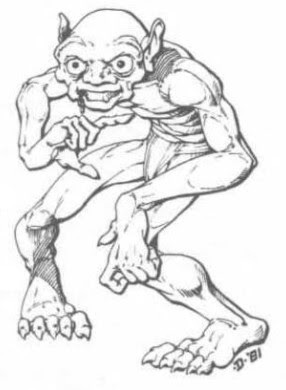 I draw your attention to the boggle because he's not terribly dissimilar in general appearance to Roslof's goblins. Of course, he also looks a bit like Gollum from the 1978 Ralph Bakshi The Lord of the Rings animated film, so what do I know? The module includes several "tactical maps" for major encounters, which are decorated with illustrations of some of the monsters found in the Stockade.
I draw your attention to the boggle because he's not terribly dissimilar in general appearance to Roslof's goblins. Of course, he also looks a bit like Gollum from the 1978 Ralph Bakshi The Lord of the Rings animated film, so what do I know? The module includes several "tactical maps" for major encounters, which are decorated with illustrations of some of the monsters found in the Stockade.
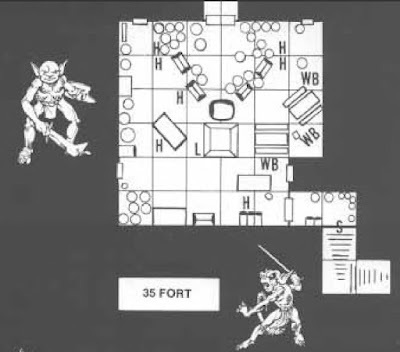 Both of these figures are drawn by Jeff Dee: the upper left being a goblin and the bottom right a kobold. Both look very similar to those drawn by Roslof for the Monster Cards. That makes me wonder if perhaps there was some level of art direction at TSR during this time or if it's simply a case of a group of artists who all cribbed from one another when drawing these creatures. I simply don't know the answer at this point, but I must confess that I'm now of a mind to see if I can find out.
Both of these figures are drawn by Jeff Dee: the upper left being a goblin and the bottom right a kobold. Both look very similar to those drawn by Roslof for the Monster Cards. That makes me wonder if perhaps there was some level of art direction at TSR during this time or if it's simply a case of a group of artists who all cribbed from one another when drawing these creatures. I simply don't know the answer at this point, but I must confess that I'm now of a mind to see if I can find out.In any case, Secret of the Slavers Stockade has the potential to be a fun module, if your players enjoy sneaking around and avoiding drawing attention to themselves. If not, it's probably going to turn into a huge combat slog and will likely result in one or more character deaths. The latter was my own experience of refereeing it in my youth, but, in those days, we were much more tolerant of gigantic slugfests than I am today. Even careful players will likely find this a difficult module, so I won't be surprised if many commenters don't share my largely positive opinion of it, which is fair. For me, I appreciate that Johnson didn't make the Stockade easy to overrun. This is, after all, the headquarters of a powerful evil organization; it should be a dangerous place and it is.
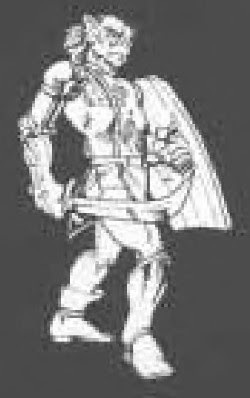 Have a blurry orc by Jeff Dee
Have a blurry orc by Jeff Dee
Kobold Variants
Investigating the art of TSR era Dungeons & Dragons is a deep rabbit hole and I expect I'll be delving into it a great deal over the next few weeks. Apologies in advance to those of you who don't find this sort of thing nearly as interesting as I do. That's why I'm briefly going to return to the subject of kobolds.
Lore Suto reminded me that Jim Roslof did some illustrations of kobolds for AD&D module A4, In the Dungeons of the Slave Lords. Here they are:
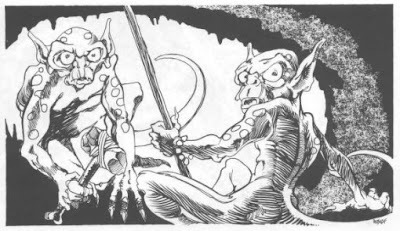 These kobolds look very similar to those he drew for the AD&D Monster Cards in that they're, for lack of a better word, more impish in appearance than the small, scaly dog-men of the Monster Manual. Also in the same module is a second depiction of a kobold, this time by Erol Otus, who had previously drawn a kobold for the Tom Moldvay Basic D&D rulebook.
These kobolds look very similar to those he drew for the AD&D Monster Cards in that they're, for lack of a better word, more impish in appearance than the small, scaly dog-men of the Monster Manual. Also in the same module is a second depiction of a kobold, this time by Erol Otus, who had previously drawn a kobold for the Tom Moldvay Basic D&D rulebook.
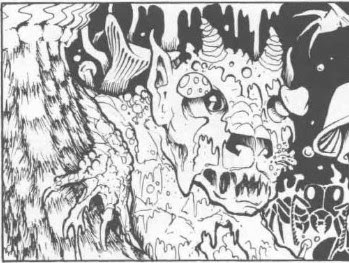 The kobold above is actually dead, reanimated via myconid spores. Even so, its appearance differs from that of Roslof's kobolds earlier in the same module. Otus's depiction is closer to those in the MM, in spite of the fact that he had previously drawn a kobold for Basic D&D with different characteristics. It's fascinating and makes me wonder about the nature of art direction during the days of TSR. Were all these variants the result of a conscious policy or was there not much direction, leaving artists largely to their own devices?
The kobold above is actually dead, reanimated via myconid spores. Even so, its appearance differs from that of Roslof's kobolds earlier in the same module. Otus's depiction is closer to those in the MM, in spite of the fact that he had previously drawn a kobold for Basic D&D with different characteristics. It's fascinating and makes me wonder about the nature of art direction during the days of TSR. Were all these variants the result of a conscious policy or was there not much direction, leaving artists largely to their own devices?
James Maliszewski's Blog
- James Maliszewski's profile
- 3 followers



